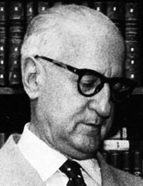

Although it is possible to find traces of his political position projected in the characterisation of his biographees, historian Octávio Tarquínio sought to avoid excessive praise of such figures, which was so common at the time. Deeply influenced by the great biographers of the first half of the 20th century, especially the British Gilles Lytton Strachey (1880-1932), the German Emil Ludwig (1881-1948) and the French André Maurois (1885-1967), Octávio Tarquínio sought in the lives and works of his characters threads that connected broader historical processes, and in their psychological characteristics elements that potentiated the realisation of such processes. Through his writing style, he also sought to distance himself from what he considered to be the romanticised emphasis of many of the biographies of the time, ultimately approaching the standards of objectivity sought by a historiographical text. In this sense, he was also indebted to the reflections of the German philosopher Wilhelm Dilthey (1833-1911) on the relationship between history and the individual – although, as the only scholar to have studied Tarquínio’s work in depth to date, Brazilian historian Márcia de Almeida Gonçalves has clearly demonstrated, this debt is often subtle. Since then, Octávio Tarquínio’s conception of biography has been based on a privileged form of writing political history in a broader sense, as the history of an era that is somehow condensed in the figure of a prominent individual (for that very reason).
And so it was that, starting with Bernardo Pereira de Vasconcelos e seu tempo, Octávio Tarquínio developed his project of writing a history of the Brazilian regency period (1831-1840) through the analysis of the actions of some of its main political protagonists. This was followed by three other books, two of which were biographies: Evaristo da Veiga (1939), now published by the Brasiliana collection of Companhia Editora Nacional; História de dois golpes de Estado (1939), again published by José Olympio as volume 18 of the , Documentos Brasileiros, which he had begun editing the previous year, replacing Gilberto Freyre; and Diogo Antônio Feijó (1784-1843) (1942), volume 35 of the same collection. The favourable reception of these works by critics and the public, as well as his growing mastery of historiography and documentation relating to 19th-century Brazil, soon prompted Octávio Tarquínio to take a partial, but significant, chronological extension of his area of interest, taking his initial historiographical project to another level: he now set out to write a history of the very foundation of independent Brazil, in which the men he biographed would be perfectly placed in their time and social milieu. The process of Brazilian independence would thus be seen as only partially realised as a result of the will and actions of its main protagonists, since it was also influenced by the attitudes of the Cortes of Lisbon, which were supposedly contrary to the “interests of Brazil,” and the divergent interests between “Portuguese” merchants operating in Brazil, on the one hand, and large landowners, urban intellectuals and the lower strata of Brazilian society, on the other. In both cases, the traditional view of an antagonistic struggle between Brazil and Portugal underlies the narrative.
This work is financed by national funds through FCT - Foundation for Science and Technology, I.P, in the scope of the projects UIDB/04311/2020 and UIDP/04311/2020.
